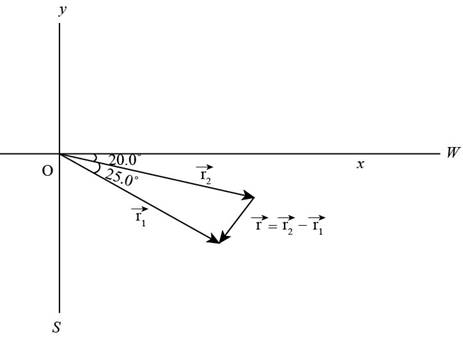
Concept explainers
An air-traffic controller observes two aircraft on his radar screen. The first is at altitude 800 m, horizontal distance 19.2 km, and 25.0° south of west. The second aircraft is at altitude 1 100 m, horizontal distance 17.6 km, and 20.0° south of west. What is the distance between the two aircraft? (Place the x axis west, the y axis south, and the z axis vertical.)
The distance between the two aircraft.
Answer to Problem 3.54AP
The distance between the two aircraft is
Explanation of Solution
Given info: The air traffic controller observes two aircraft on his radar screen. The first is at altitude
Consider the

Figure (1)
The displacement vector of the first aircraft in the
Here,
Substitute
Thus, the displacement vector of the first aircraft in
The displacement vector of the first aircraft in the
Here,
Substitute
Thus, the displacement vector of the first aircraft in
The displacement vector of the first aircraft in the
Here,
Substitute
Thus, the displacement vector of the first aircraft in
The position vector of the first aircraft is,
Here,
Substitute
Thus, the position vector of the first aircraft is
The displacement vector of the second aircraft in the
Here,
Substitute
Thus, the displacement vector of the second aircraft in
The displacement vector of the second aircraft in the
Here,
Substitute
Thus, the displacement vector of the second aircraft in
The displacement vector of the second aircraft in the
Here,
Substitute
Thus, the displacement vector of the second aircraft in
The position vector of the second aircraft is,
Here,
Substitute
Thus, the position vector of the second aircraft is
The net distance vector between the two aircraft is,
Here,
Substitute
Thus, the net distance vector between the two aircraft is
The magnitude for the net distance vector between the two aircraft is,
Here,
Substitute
Conclusion:
Therefore, the distance between the two aircraft is
Want to see more full solutions like this?
Chapter 3 Solutions
Bundle: Physics for Scientists and Engineers, Technology Update, 9th Loose-leaf Version + WebAssign Printed Access Card, Multi-Term
Additional Science Textbook Solutions
Fundamentals of Physics Extended
Applications and Investigations in Earth Science (9th Edition)
Organic Chemistry (8th Edition)
EBK INTRODUCTION TO CHEMISTRY
Loose Leaf For Integrated Principles Of Zoology
- Please help me with this physics problemarrow_forwardIn a scene from The Avengers (the first one) Black Widow is boosted directly upwards by Captain America, where she then grabs on to a Chitauri speeder that is 15.0 feet above her and hangs on. She is in the air for 1.04 s. A) With what initial velocity was Black Widow launched? 1 m = 3.28 ft B) What was Black Widow’s velocity just before she grabbed the speeder? Assume upwards is the positive direction.arrow_forwardIn Dark Souls 3 you can kill the Ancient Wyvern by dropping on its head from above it. Let’s say you jump off the ledge with an initial velocity of 3.86 mph and spend 1.72 s in the air before hitting the wyvern’s head. Assume the gravity is the same as that of Earth and upwards is the positive direction. Also, 1 mile = 1609 m. A) How high up is the the ledge you jumped from as measured from the wyvern’s head? B) What is your velocity when you hit the wyvern?arrow_forward
- No chatgpt pls will upvote Alreadyarrow_forwardTwo objects get pushed by the same magnitude of force. One object is 10x more massive. How does the rate of change of momentum for the more massive object compare with the less massive one? Please be able to explain why in terms of a quantitative statement found in the chapter.arrow_forwardA box is dropped on a level conveyor belt that is moving at 4.5 m/s in the +x direction in a shipping facility. The box/belt friction coefficient is 0.15. For what duration will the box slide on the belt? In which direction does the friction force act on the box? How far will the box have moved horizontally by the time it stops sliding along the belt?arrow_forward
 Principles of Physics: A Calculus-Based TextPhysicsISBN:9781133104261Author:Raymond A. Serway, John W. JewettPublisher:Cengage Learning
Principles of Physics: A Calculus-Based TextPhysicsISBN:9781133104261Author:Raymond A. Serway, John W. JewettPublisher:Cengage Learning An Introduction to Physical SciencePhysicsISBN:9781305079137Author:James Shipman, Jerry D. Wilson, Charles A. Higgins, Omar TorresPublisher:Cengage Learning
An Introduction to Physical SciencePhysicsISBN:9781305079137Author:James Shipman, Jerry D. Wilson, Charles A. Higgins, Omar TorresPublisher:Cengage Learning Physics for Scientists and EngineersPhysicsISBN:9781337553278Author:Raymond A. Serway, John W. JewettPublisher:Cengage Learning
Physics for Scientists and EngineersPhysicsISBN:9781337553278Author:Raymond A. Serway, John W. JewettPublisher:Cengage Learning Physics for Scientists and Engineers with Modern ...PhysicsISBN:9781337553292Author:Raymond A. Serway, John W. JewettPublisher:Cengage Learning
Physics for Scientists and Engineers with Modern ...PhysicsISBN:9781337553292Author:Raymond A. Serway, John W. JewettPublisher:Cengage Learning Glencoe Physics: Principles and Problems, Student...PhysicsISBN:9780078807213Author:Paul W. ZitzewitzPublisher:Glencoe/McGraw-Hill
Glencoe Physics: Principles and Problems, Student...PhysicsISBN:9780078807213Author:Paul W. ZitzewitzPublisher:Glencoe/McGraw-Hill University Physics Volume 1PhysicsISBN:9781938168277Author:William Moebs, Samuel J. Ling, Jeff SannyPublisher:OpenStax - Rice University
University Physics Volume 1PhysicsISBN:9781938168277Author:William Moebs, Samuel J. Ling, Jeff SannyPublisher:OpenStax - Rice University





